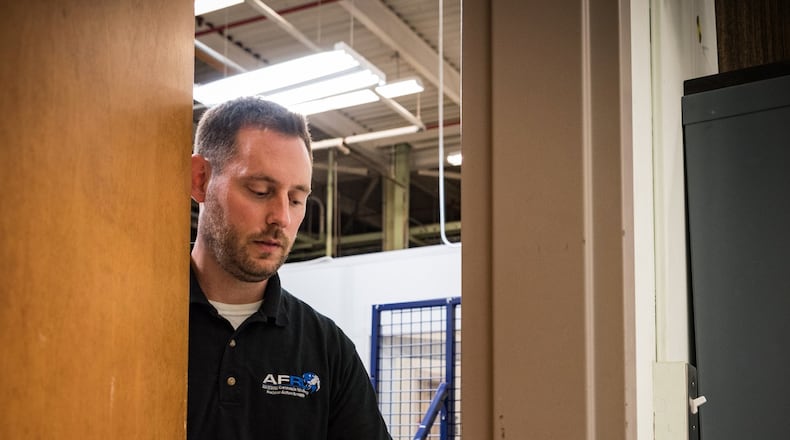Co-inventor Matt Srnoyachki — founder of S9 Engineering and a mechanical engineer in the AFRL’s 711th Human Performance Wing — brought a pair of the devices to a recent interview, easily holding them folded up in one hand.
Don’t be fooled by size of this “fortress.” The military-spec invention is meant to be placed firmly between a door frame and a door’s striker plate, securing a metal block that prevents intruders from pushing a door open. The metal block can be pivoted shut or opened easily from the inside.
MORE: GM just bought this local land for a new plant. Find out where.
Those who insert the device and lock it in place can flee to safety elsewhere, or simply move away from a closed door.
There aren’t a lot of options in mass-shooting situations — fight, flee or hide. No device in these scenarios can be completely foolproof, Srnoyachki acknowledges. The device does nothing for windows. And an armed intruder can still shoot into a locked door or attempt to smash that door open.
But Srnoyachki and his colleagues believe this device will delay almost any intruder — giving first responders, teachers, students and others additional minutes.
MORE: This Beavercreek defense firm has hired a retired AFRL vice commander
“We’ve been researching active-threat situations since 2015,” said Srnoyachki, who has worked for AFRL since 2011 as a contractor. “What we’ve learned is, these are very time-critical situations. And unless there’s a motive behind the assailant, then he’s going to try to get into the door for a moment — then if he can’t really get in, he’s going to keep moving.”
Srnoyachki said the invention has been tested against “just about every single portable travel lock, portable door lock that you can find on the market.”
“We found deficiencies with all of them,” he said. “We were either able to kick through them very easily; they were made poorly; they didn’t fit in the doors that we commonly see.”
MORE: One of downtown's most important buildings has been auctioned off. Who was the winning bidder?
This door lock is effective in “90 percent of the commercial door frames that we found, both industrial and household,” he added.
The license agreement involves undisclosed fees and royalties which are to be repaid to the Air Force. Srnoyachki said he is looking for manufacturers to refine prototypes and purse full-scale production. He declined to name any of those companies.
The product is open to military and non-military customers alike, and it’s ADA (“Americans with Disabilities Act”) -compliant, he said.
“Young children, the elderly, anyone who isn’t very mechanically inclined, if they see this thing in the door, all they simply do is pull the tab,” Srnoyachki said.
He envisions a street price of around $50 for the piece.
“To me, this is pretty ingenious,” said Bob Lee, an Innovation Project manager at the Wright Brothers Institute in Riverside.
The Gun Violence Archive counts 365 mass shootings in the United States since Jan. 1, 2019, counting events the archive says have been reported and verified.
Srnoyachki said a national challenge to work on the device came straight from the top at AFRL, with an invention team taking up that challenge with prototypes in 2015 — well before the Aug. 4 mass shooting in Dayton’s Oregon District that resulted in 10 deaths, including the shooter’s death.
TechLink, the Montana-based Department of Defense’s national partnership intermediary for technology transfer, helped facilitate the license agreement with the Air Force technology transfer office.
About the Author

